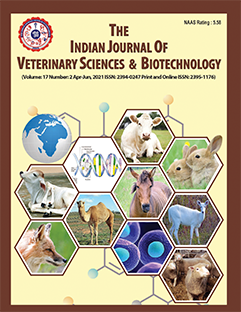Epidemiological Study of Canine Parvoviral Enteritis in Jaipur, Rajasthan
DOI:
https://doi.org/10.48165/ijvsbt.21.6.32Keywords:
Canine parvovirus, Climatic risk factors, Epidemiology, Seasonal variation, VaccinationAbstract
Canine Parvo Virus (CPV) is a major cause of morbidity and mortality in young dogs globally. The epidemiological study was conducted in Jaipur, Rajasthan (India) to assess the occurrence of CPVE and its association with climatic and host-related risk factors over a six month period (July to December 2024). A total of 200 faecal samples from clinically suspected dogs were tested using PCR, revealing an overall CPV positive rate of 83% (166/200). Month-wise analysis demonstrated a significant decline in positivity rate from July (96.7%) to December (10.0%), correlating with climatic temperature. Statistical analysis confirmed significant associations (p<0.05) between CPV infection and factors like age, sex, vaccination status and breed. Puppies aged under one year and unvaccinated dogs were most susceptible. The study underscores the seasonal nature of CPVE in Jaipur and highlights the importance of early vaccination, public awareness and climate informed disease surveillance to mitigate the impact of this highly contagious disease.Downloads
References
Altman, K.D., Kelman, M., & Ward, M.P. (2017). Are vaccine strain, type or administration protocol risk factors for canine parvovirus vaccine failure? Veterinary Microbiology, 210, 8-16.
Behara, A., Ahn, J., Shah, N., Jakate, S., Howard, A., & Cohen, S. (2008). Parvovirus B19 associated hepatitis complicated by aplastic anemia: 591. Official Journal of the American College of Gastroenterology, 103, S229.
Behera, M., Panda, A.K., & Sahoo, M. (2015). Canine parvovirus infection in Bhubaneswar, Odisha: Breed-wise incidence rates. Veterinary Pathology, 54(5), 502-507.
Decaro, N., & Buonavoglia, C. (2012). Canine parvovirus - A review of epidemiological and diagnostic aspects, with emphasis on type 2c. Veterinary Microbiology, 155(1), 1-12.
Decaro, N., Buonavoglia, C., & Barrs, V.R. (2020). Canine parvovirus vaccination and immunisation failures: Are we far from disease eradication? Veterinary Microbiology, 247, 108760.
Gombac, M., Švara, T., Tadić, M., & Pogačnik, M. (2008). Retrospective study of canine parvovirosis in Slovenia. Slovenia Veterinary Research, 45(2), 73-78.
Grecco, S., Condon, E., Bucafusco, D., Bratanich, A.C., Panzera, Y., & Pérez, R. (2024). Comparative genomics of canine parvovirus in South America: Diversification patterns in local populations. Infection, Genetics and Evolution, 105, 105633.
Ismail, W.F., & Hanedan, B. (2024). Investigation of prevalence and risk factors of parvovirus infection in Eurasian. Journal of Veterinary Science, 40(1), 16-23.
Melo, T.F., Rodrigues, C.P., Abreu, C.B., Hirsch, C., Galinari, G.C.F., Costa, É.A., et al. (2023). Systemic inflammatory response syndrome: A risk factor associated with poor prognosis of dogs infected with canine parvovirus 2. Ciência Rural, 54(6), e20220517.
Miranda, C., Carvalheira, J., Parrish, C.R., & Thompson, G. (2015). Factors affecting the occurrence of canine parvovirus in dogs. Veterinary Microbiology, 180(1-2), 59-64.
Mukhopadhyay, H.K., Matta, S.L., Amsaveni, S., Antony, P.X., Thanislass, J., & Pillai, R.M. (2014). Phylogenetic analysis of canine parvovirus partial VP2 gene in India. Virus Genes, 48, 89-95.
Nandi, S., & Kumar, M. (2010). Canine parvovirus: current perspective. Indian Journal of Virology, 21, 31-44.
Sanaei, N., Zamani-Ahmadmahmudi, M., & Nassiri, S.M. (2025). Development of machine learning models to predict clinical outcome and recovery time in dogs with parvovirus enteritis. Frontiers in Veterinary Science, 12, 1555714.
Sharma, S., Dhar, P., Thakur, A., Sharma, V., & Sharma, M. (2016). First detection of canine parvovirus type 2b from diarrheic dogs in Himachal Pradesh. Veterinary World, 9(9), 964-969.
Sunghan, J., Akatvipat, A., Granick, J., Chuammitri, P., & Boonyayatra, S. (2019). Clinical factors associated with death during hospitalization in parvovirus infection dogs. Veterinary Integrative Sciences, 17(2), 171-180.
Downloads
Published
Issue
Section
License
Copyright (c) 2025 Indian Journal of Veterinary Sciences and Biotechnology

This work is licensed under a Creative Commons Attribution-NonCommercial-NoDerivatives 4.0 International License.




